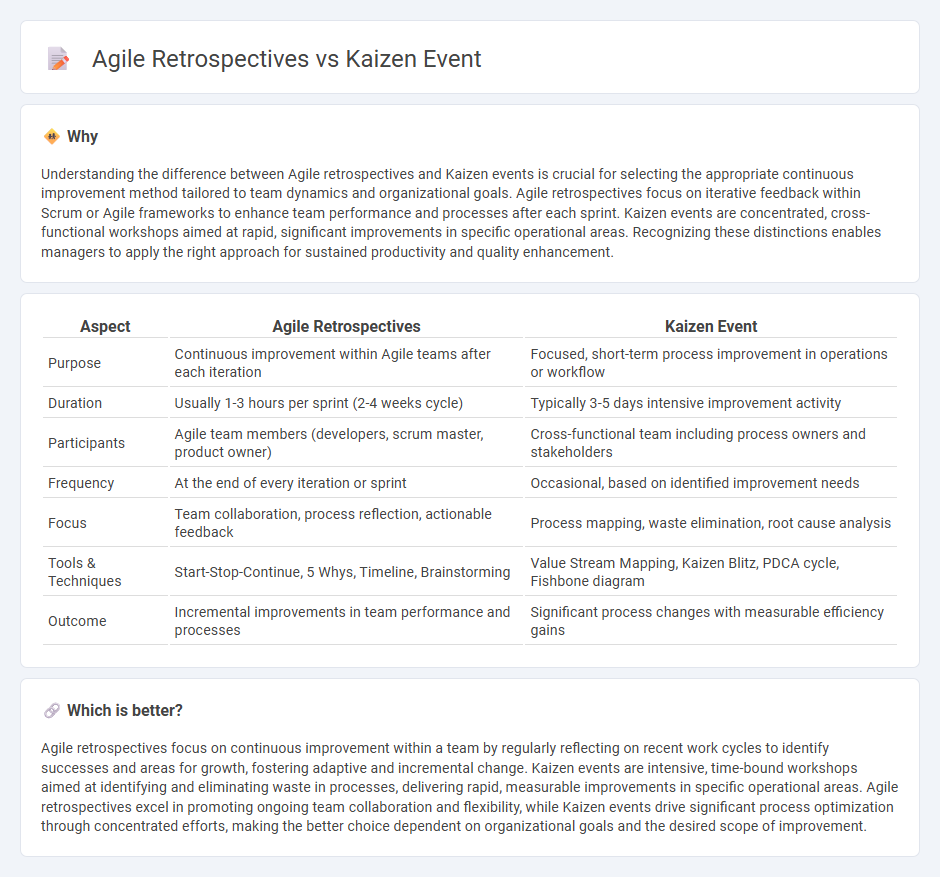
Agile retrospectives focus on continuous team improvement through regular reflection and feedback cycles at the end of each sprint, emphasizing adaptability and collaboration. Kaizen events are intensive, short-term workshops aimed at identifying and resolving specific process inefficiencies to drive gradual but impactful organizational change. Explore deeper insights into how Agile retrospectives and Kaizen events can transform your management practices.
Why it is important
Understanding the difference between Agile retrospectives and Kaizen events is crucial for selecting the appropriate continuous improvement method tailored to team dynamics and organizational goals. Agile retrospectives focus on iterative feedback within Scrum or Agile frameworks to enhance team performance and processes after each sprint. Kaizen events are concentrated, cross-functional workshops aimed at rapid, significant improvements in specific operational areas. Recognizing these distinctions enables managers to apply the right approach for sustained productivity and quality enhancement.
Comparison Table
| Aspect | Agile Retrospectives | Kaizen Event |
|---|---|---|
| Purpose | Continuous improvement within Agile teams after each iteration | Focused, short-term process improvement in operations or workflow |
| Duration | Usually 1-3 hours per sprint (2-4 weeks cycle) | Typically 3-5 days intensive improvement activity |
| Participants | Agile team members (developers, scrum master, product owner) | Cross-functional team including process owners and stakeholders |
| Frequency | At the end of every iteration or sprint | Occasional, based on identified improvement needs |
| Focus | Team collaboration, process reflection, actionable feedback | Process mapping, waste elimination, root cause analysis |
| Tools & Techniques | Start-Stop-Continue, 5 Whys, Timeline, Brainstorming | Value Stream Mapping, Kaizen Blitz, PDCA cycle, Fishbone diagram |
| Outcome | Incremental improvements in team performance and processes | Significant process changes with measurable efficiency gains |
Which is better?
Agile retrospectives focus on continuous improvement within a team by regularly reflecting on recent work cycles to identify successes and areas for growth, fostering adaptive and incremental change. Kaizen events are intensive, time-bound workshops aimed at identifying and eliminating waste in processes, delivering rapid, measurable improvements in specific operational areas. Agile retrospectives excel in promoting ongoing team collaboration and flexibility, while Kaizen events drive significant process optimization through concentrated efforts, making the better choice dependent on organizational goals and the desired scope of improvement.
Connection
Agile retrospectives and Kaizen events both focus on continuous improvement by encouraging teams to regularly reflect on processes, identify inefficiencies, and implement actionable changes. Agile retrospectives occur at the end of each sprint, fostering iterative development and team collaboration, while Kaizen events are structured, short-term projects aimed at eliminating waste and optimizing workflows. Both methodologies emphasize employee involvement and data-driven decision-making to enhance productivity and quality within organizations.
Key Terms
Continuous Improvement
Kaizen events are structured, short-term workshops aimed at rapid, incremental process improvements primarily in manufacturing and operational settings, emphasizing root cause analysis and waste reduction. Agile retrospectives, on the other hand, are iterative review meetings within software development cycles focused on team collaboration, adapting processes, and fostering continuous learning. Explore deeper insights into how both methods drive continuous improvement across industries.
Iterative Feedback
Kaizen events concentrate on rapid, focused improvement cycles within a specific timeframe, driving continuous operational enhancements through iterative feedback and team collaboration. Agile retrospectives emphasize regular reflection at the end of each sprint, fostering adaptive learning and process refinements to improve team performance and product quality. Explore deeper insights on how iterative feedback shapes both Kaizen events and Agile retrospectives for sustained success.
Action Items
Kaizen events prioritize rapid, focused improvements by implementing specific action items within a short timeframe, aiming to eliminate waste and enhance processes immediately. Agile retrospectives focus on continuous team reflection and iterative action items to improve collaboration, productivity, and project outcomes over successive sprints. Explore how integrating both approaches can drive sustained organizational growth and efficiency.
Source and External Links
Kaizen Event: What Is it, When Is it Used, and How Does it Work? - A Kaizen Event is a short-term brainstorming session focused on improving a specific process, typically lasting three to five days and involving diverse teams to achieve rapid process improvements.
What Is A KAIZEN(tm) Event - A KAIZEN Event is an intensive workshop that involves employees in designing and implementing improvements, divided into preparation, implementation, and follow-up phases.
How Kaizen Events Drive Continuous Improvement - Kaizen Events are 3-5 day workshops aimed at solving specific process improvement goals through collaborative problem-solving, hands-on learning, and interdisciplinary teamwork.
 dowidth.com
dowidth.com